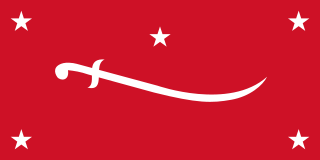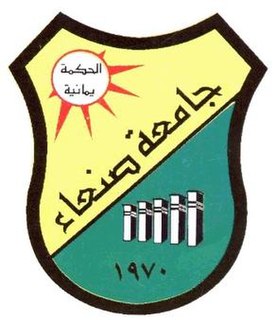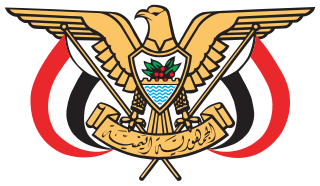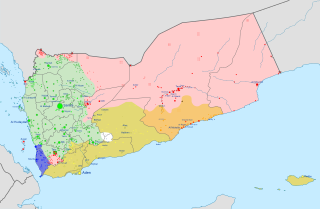Related Research Articles

The Politics of Yemen are in an uncertain state due to the Houthi takeover in Yemen. An armed group known as the Houthis or Ansar Allah seized control of the Northern Yemeni government and announced it would dissolve parliament, as well as install a "presidential council", "transitional national council", and "supreme revolutionary council" to govern the country for an interim period. However, the deposed president, Abdrabbuh Mansur Hadi, has declared he is still in office and is working to establish a rival government in Aden.

The Armed Forces of Yemen are the military forces of the Republic of Yemen. They include the Yemeni Army, Yemeni Navy and the Yemeni Air Force. The capital of the country, Sana’a is where the military is headquartered. Per the constitution of Yemen, the President of Yemen serves as the commander-in-chief.

Ali Abdullah Saleh al-Ahmar was a Yemeni politician who served as the first President of Yemen, from Yemeni unification on 22 May 1990 to his resignation on 25 February 2012, following the Yemeni Revolution. Previously, he had served as President of the Yemen Arab Republic, or North Yemen, from July 1978 to 22 May 1990, after the assassination of President Ahmad al-Ghashmi.

Yemen ,or The Yemen, officially the Republic of Yemen, and historically known as South Arabia, is a country in Western Asia, on the southern end of the Arabian Peninsula. It borders Saudi Arabia to the north and Oman to the northeast and shares maritime borders with Eritrea, Djibouti, and Somalia. It is the second-largest Arab sovereign state in the peninsula, occupying 555,000 square kilometres. The coastline stretches for about 2,000 kilometres. Yemen's constitutionally stated capital, and largest city, is the city of Sana’a. As of 2021, the population of the country is estimated at 30,491,000.

The Yemen Arab Republic, also known simply as North Yemen or Yemen (Sanaʽa), was a country from 1962 to 1990 in the northwestern part of what is now Yemen. Its capital was at Sanaʽa. It united with the People's Democratic Republic of Yemen on May 22, 1990 to form the current Republic of Yemen.

South Yemen, officially the People's Democratic Republic of Yemen, also referred to as Democratic Yemen or Yemen (Aden), was a socialist country that existed from 1967 to 1990 as a state in the Middle East in the southern and eastern provinces of the present-day Republic of Yemen, including the island of Socotra.

North Yemen was a country that existed in the Arabian Peninsula from 1918 to 1990 in the northern part of what is now Yemen. Its capital was Sanaa from 1918 to 1948 and again from 1962 to 1990. In 1962, the country fought a bloody civil war until the monarchist defeat in 1970. North Yemen was admitted to the United Nations on September 30, 1947, and was one of the predecessor states of Yemen, alongside South Yemen, until its eventual unification. In 2014, the Houthi movement took control parts of North Yemen, which eventually escalated into a civil war.
The Yemen Times was Yemen's first and most widely read independent English-language newspaper. The paper was published daily and had its own printing press, advertising associates and news service before going defunct in 2014 due to the war. Its website clearly states the paper is not operating.
Yemeni unification took place on May 22, 1990, when the area of the People's Democratic Republic of Yemen was united with the Yemen Arab Republic, forming the Republic of Yemen.
The modern history of Yemen began with the withdrawal of the Ottoman Empire. In 1839 the British set up a protective area around the southern port of Aden and in 1918 the northern Kingdom of Yemen gained independence from the Ottoman Empire. North Yemen became a republic in 1962, but it was not until 1967 that the British Empire withdrew from what became South Yemen. In 1970, the southern government adopted a communist governmental system. The two countries were formally united as the Republic of Yemen on May 22, 1990.

Sana'a University was established in 1970 as the first and the primary university in the Yemen Arab Republic, now the Republic of Yemen. It is located in Sanaa, the capital of Yemen, and is currently organized with 17 faculties. Previously the university was located at 15°20′53.16″N44°11′26.83″E and was built on the grounds of the old Jewish cemetery. The university includes several accommodation buildings for staff and students and is partnered with the Kuwait University Hospital for medical students.

The Houthi insurgency in Yemen, also known as the Houthi rebellion, the Sa'dah War, or the Sa'dah conflict, was a military rebellion pitting Zaidi Shia Houthis against the Yemeni military that began in Northern Yemen and has since escalated into a full-scale civil war. The conflict was sparked in 2004 by the government's attempt to arrest Hussein Badreddin al-Houthi, a Zaidi religious leader of the Houthis and a former parliamentarian on whose head the government had placed a $55,000 bounty.
Yemen's Ministry of Information influences the mass media through its control of printing presses, granting of newspaper subsidies, and ownership of the country's only television and radio stations. Yemen has nine government-controlled, 50 independent, and 30 party-affiliated newspapers. There are approximately 90 magazines, 50 percent of which are private, 30 percent government-controlled, and 20 percent party-affiliated. The government controls the content of news broadcasts and edits coverage of televised parliamentary debates.
Al-Wasat, also Alwasat, was an Arabic-language daily newspaper in Manama, Bahrain. Al-Wasat was generally regarded as the only independent newspaper in Bahrain. The newspaper ran for 15 years, during which is provided reporting unique to Bahrain.

The Yemeni Revolution (intifada), also known as the Yemeni Revolution of Dignity followed the initial stages of the Tunisian Revolution and occurred simultaneously with the Egyptian Revolution of 2011 and other Arab Spring protests in the Middle East and North Africa. In its early phase, protests in Yemen were initially against unemployment, economic conditions and corruption, as well as against the government's proposals to modify Yemen's constitution. The protesters' demands then escalated to calls for the resignation of Yemeni President Ali Abdullah Saleh. Mass defections from the military, as well as from Saleh's government, effectively rendered much of the country outside of the government's control, and protesters vowed to defy its authority.
14 October is an Arabic daily newspaper published in Aden, Yemen. The paper has been in circulation since 1968. The paper was named after the revolution in the South of Yemen on 14 October 1967.

The Ministry of Foreign Affairs is a cabinet ministry of Yemen. The ministry is responsible for conducting foreign relations of the country.
The Timeline of the Yemeni Crisis (2011–present) refers to events of the Houthi insurgency in Yemen, the Yemeni Revolution, the Al-Qaeda insurgency in Yemen and the South Yemen insurgency.

The Yemeni Civil War is an ongoing multilateral civil war that began in late 2014 mainly between the Abdrabbuh Mansur Hadi-led Yemeni government and the Houthi armed movement, along with their supporters and allies. Both claim to constitute the official government of Yemen.

The Saudi Arabian-led intervention in Yemen is an intervention launched by Saudi Arabia on 26 March 2015, leading a coalition of nine countries from West Asia and North Africa, responding to calls from the president of Yemen Abdrabbuh Mansur Hadi for military support after he was ousted by the Houthi movement, despite the progress in the political transition led by the United Nations at that time. The conflict ignited between the government forces, the Houthi rebels and other armed groups after the draft constitution and power-sharing arrangements collapsed leading to an escalation of violence in mid-2014. The Houthis and allied units of the armed forces seized control of Sana’a and other parts of the country in September 2014 and in the following months. This prompted president Saleh to ask Saudi Arabia to intervene against the Iranian backed Houthis.
References
- 1 2 3 Reporters without Borders, 5 May 2009, Major crackdown on independent media Archived 2010-01-09 at the Wayback Machine
- ↑ Obituary: Hisham Ba-Shraheel and al-Ayyam: an unfinished journey Archived 2014-05-23 at the Wayback Machine Al Bab. Retrieved 11 September 2014.
- ↑ Reporters without Borders, 15 February 2008, Armed attack on independent daily’s office in Sanaa
- ↑ "Independent newspapers in Yemen: Situation and future horizons" (Report). Yemen Polling Center. 10 May 2012. Retrieved 11 September 2014.
- ↑ صحيفة عدنية عريقة تعود للصدور بعد توقف دام سنواتاقرأ المزيد من عدن الغد | صحيفة عدنية عريقة تعود للصدور بعد توقف دام سنوات (مصور) Aden Al Ghad. Retrieved 11 September 2014.